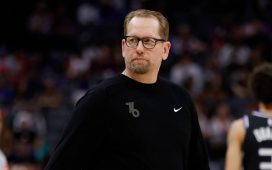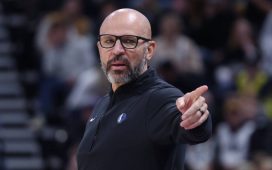When Tyson Walker, a 6-foot point guard from Westbury, N.Y., transferred to Michigan State from Northeastern this month, he had one goal in mind.
After a breakout season in which he averaged 18.8 points per game and was named a finalist for the Lou Henson Award, given to the top men’s basketball player from a mid-major conference, Walker was ready to play for a team with a shot at making the Final Four next year in New Orleans. He made his announcement in late March in a Twitter post portraying him in a Michigan State uniform.
“My whole decision was based off just trying to play at the highest level,” Walker said.
Walker is in a large group of Division I men’s and women’s basketball players who will benefit from a new rule that allows them to jump to new schools and immediately become eligible to play. The rule, which allows just one unrestricted transfer per athlete, was tentatively approved by an N.C.A.A. panel on Wednesday, said a person close to the negotiations who was not authorized to speak publicly about the matter. Final approval is expected this month.
The rule change, which is expected to be permanent, has turned the college basketball off-season into something akin to N.B.A. free agency, with more than 1,400 men — about 30 percent of the players on all 357 Division I men’s programs — already in the N.C.A.A. transfer portal. Three years ago, just 882 male Division I basketball players entered the portal. On the women’s side, there are about 1,000 players in the portal — or about 18 percent of all Division I players.
Ordinarily, transfers would have had to sit out the 2021-22 season because of N.C.A.A. rules that apply to football, baseball, men’s and women’s basketball and men’s ice hockey. But the N.C.A.A.’s Division I Council approved a proposal granting first-time transfers in all sports immediate eligibility without restrictions. The change had been expected for some time, contributing to the extraordinary numbers of players in the portal.
The numbers may also be higher than usual because of accommodations made to account for disruptions related to the coronavirus: Any fourth-year senior who wishes to return to school and compete for an additional year will be granted the opportunity to do so, though that doesn’t guarantee a scholarship will be available. Generally, a player who graduates from one institution is often eligible to play at another as a graduate transfer.
Jason Setchen, a Miami lawyer who is an advocate for student-athletes, said he believed the transfer ruling was much needed.
“The one piece that was missing was the immediate eligibility component because you could enter the portal and transfer to a school where you sought a better opportunity, but you still had to sit a year, unless you had graduated,” Setchen said in a phone interview. “So it was really almost halfway to where it needed to be in order to give kids a real opportunity to be able to improve their position immediately.”
Critics of the transfer-rule exception say it has already turned college basketball into the “Wild West,” where any unhappy player will simply transfer instead of trying to work their situation out with his or her coaches.
A number of men’s programs, like St. John’s, Iowa State and U.N.L.V., have a half-dozen or more players in the portal, according to the website VerbalCommits. After reaching the second round of the men’s N.C.A.A. tournament, Florida has already added four transfers to replace the four it lost. At Memphis, which won the National Invitation Tournament under Coach Penny Hardaway, three players announced their transfers on March 31. On the women’s side, Syracuse has 11 players in the portal; Texas Tech has 10.
Some players are giving new meaning to the term “well-traveled.” DePaul guard Charlie Moore entered the portal, and his next college will be his fourth, including previous stops at California and Kansas. Because he is not a first-time transfer, he will need a waiver at his new college, but that is expected to be a formality.
“This transferring all over the place is going to destroy our great game,” Dick Vitale, the ESPN college basketball analyst, tweeted. He argued that players should not be allowed to transfer without sitting out a year unless a coach leaves.
In a letter to the N.C.A.A.’s transfer working group, Matt Painter, the Purdue men’s coach and a member of the board of the National Association of Basketball Coaches, voiced opposition to the one-time transfer waiver. Painter said it would usher in an era of “free agency” and would make life more complicated for both high school and college student-athletes.
“Every classification of student-athletes — both current and prospective — would experience uncertainty,” Painter wrote in his letter. “The annual roster turnover would make college choices more difficult for high school prospects, and current student-athletes contemplating transfer would have less certainty with which to make decisions.
“As a coach, the ability to effectively teach and lead a program would be more difficult. And perhaps most significantly, remaining student-athletes would be left in an untenable situation in the likely event of a mass exodus of teammates in a single off-season.”
Think of the situation as a gigantic game of musical chairs, in which players are looking for a new opportunity before the music stops. Even Setchen believes that there won’t be enough spaces for every player in the portal to find a good fit.
N.C.A.A. rules prohibit student-athletes from communicating with other colleges until they have entered the transfer portal, at which point their current schools may cancel their scholarships, Setchen said.
“So what happens is these kids are going into the portal thinking they’re going to have all kinds of opportunities, and then all of a sudden they don’t have any,” he said. “And then some have to drop down to a random school just to play, and now they’re stuck in what could be a worse situation than the one that they left.”
Supporters of the one-time transfer exception have long said it is unfair to force players to sit out for a year upon transferring while coaches like T.J. Otzelberger (who left U.N.L.V. for Iowa State), Shaka Smart (who shifted from Texas to Marquette) and Chris Beard (who left Texas Tech for the in-conference rival Texas) can change jobs and work immediately at their new colleges.
“I also think it brings some fairness to the table because everybody’s situation is different,” said Chris Lykes, a guard who last week announced his transfer to Arkansas from Miami. “I feel the opportunity should be there for players if they feel like it is the best move for their career.”
MaCio Teague, one of two transfer starters on Baylor’s national championship team and one of eight among the men’s Final Four teams, left North Carolina Asheville after a coaching change and had to sit out a season. He didn’t think that was fair.
“My coaching staff left and I had no hard feelings for them,” Teague told Stadium’s Jeff Goodman in an interview. “They left and I decided to play. And they coached right away and I felt like I should’ve been able to play.”
Villanova Coach Jay Wright, whose team won the 2018 championship while relying on Eric Paschall, a transfer from Fordham who is now with the Golden State Warriors, said that he didn’t think the one-time transfer exception would be good for college basketball but that he believed it would benefit the players.
“It’s going to make it a little messier, but I think college basketball will be fine,” Wright said. “But I definitely think it’s going to give student-athletes a lot more choices and a lot more voice in their careers.”
Diamond Johnson, rated by some analysts as the No. 1 transfer in women’s college basketball, committed to North Carolina State on Friday after leaving Rutgers. A 5-foot-5 guard, Johnson averaged 17.6 points and 4.2 rebounds for the Scarlet Knights last season after arriving as the nation’s sixth-ranked recruit.
She said that she had transferred with the expectation that she would be able to play right away, and that she felt she deserved that opportunity.
“I really don’t see any reason why we should sit out a whole year,” Johnson said in a phone interview. “I think that should be up to the players whether they want to play or not.”
The new transfer rule also has a trickle-down effect on high school players.
Adam Berkowitz oversees the college-bound program at New Heights, a nonprofit, sports-based youth development organization in New York. He said he had several unsigned high school seniors he was trying to place with colleges this spring. He said that 28 of the 35 colleges he had contacted were focused on building through the transfer portal instead of recruiting high school seniors.
“That’s unprecedented,” Berkowitz said.
Tony Bozzella, the Seton Hall women’s coach, said he would have four scholarships to give out for next season.
“I’m not using them on four freshmen,” he said, “because there will probably be transfers available with college experience.”
Alan Blinder contributed reporting.





